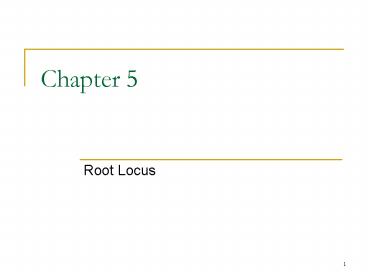Root Locus PowerPoint PPT Presentation
1 / 35
Title: Root Locus
1
Chapter 5
- Root Locus
2
Introduction
- Root Locus illustrates how the poles of the
closed-loop system vary with the closed-loop
gain.
- Graphically, the locus is the set of paths in
the complex plane traced by the closed-loop poles
as the root locus gain is varied from zero to
infinity.
3
Example of Root Locus
Locus for a system with three poles and no zeros
4
Locus for a system with three poles and two
zeros. Note that the part of the locus off the
real axis is close to joining with the real axis,
in which case break points would occur.
5
Locus for a system with 5 poles and 2 zeros.
6
5
-36.87o
4
-3
0
-2
-4
36.87o
-5
7
(No Transcript)
8
block diagram of the closed loop system
given a forward-loop transfer function
KGc(s)H(s)
where K is the root locus gain, and the
corresponding closed-loop transfer function
the root locus is the set of paths traced by the
roots of
1 KGc(s)H(s) 0
- as K varies from zero to infinity. As K changes,
the solution to this equation changes.
9
So basically, the root locus is sketch based on
the characteristic equation of a given transfer
function.
Let say
Thus, the characteristic equation
10
Root locus starts from the characteristic
equation.
Split into 2 equations
Magnitude condition
Angle condition
where
11
Remarks
If Si is a root of the characteristic equation,
then 1G(s)H(s) 0 OR Both the magnitude and
Angle conditions must be satisfied
If not satisfied? Not part of root locus
12
Let say my first search point, S1
S1
0
-1
-2
(A) Satisfy the angle condition FIRST
(B) Magnitude condition to find K
13
Let say the next search point
0
-1
-2
Check whether satisfy angle condition
Since angle condition was not satisfied ? not
part of root locus
14
CONSTRUCTION RULES OF ROOT LOCUS
- 8 RULES TO FOLLOW
15
Construction Rules of Root Locus
Then
16
Thus
17
Rule 1 When K 0
? Root at open loop poles
- The R-L starts from open loop poles
- The number of segments is equal to the number of
open loop poles
18
Rule 2 When K 8
- The R-L terminates (end) at the open loop zeros
19
Rule 3 Real-axis segments
On the real axis, for K gt 0 the root locus exists
to the left of an odd number of real-axis, finite
open-loop poles and/or finite open-loop zeros
Example 2
R-L doesnt exist here
R-L exist here
R-L exist here
20
Rule 4 Angle of asymptote
NP number of poles NZ number of zeros
21
Example 3
NP3
NZ0
Centroid
22
Rule 5 Centroid
From example 3
Recall
Thus,
-1
23
Rule 6 Break away break in points (if exist)
0
0
-1
-1
-2
-2
Break away point
Break in point
How to find these points ?
24
Differentiate K with respect to S equate to zero
How ?
Solve for S ? this value will either be the break
away or break in point
25
Let say
Thus,
26
Example 4
Solution
0
-1
-2
27
Example Root Locus
0
-1
-2
NP 3 NZ 0
28
0
-1
-2
29
Break away point
Invalid, why ???
30
How to determine these values ?
0
-1
-2
-0.42
31
Rule 7 R-L crosses j?-axis (if exist)
If there is a breakaway/ break in point
Use Routh Hurwitz
32
From characteristic equation
Construct the Routh array
33
Since
Force S1 row to zero or K6
Replace K6 into S2 row
34
0
-1
-2
-0.42
35
Rule 8 Angle of departure (arrival) (if exist)
No complex conjugate poles/zeros
35

